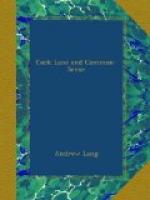Say we are Protestants, and sceptical, like Reginald Scot (1584), or Whigs, like De Foe, we then exclaim with Scot, in his Discovery of Witchcraft (1584), that minor miracles, moving tables, have gone out with benighted Popery, as De Foe also boasts in his History of the Devil. Alas, of the table we must admit eppur si muove; it moves, or is believed by foreign savants to move, for a peasant medium, Eusapia Paladino. Mr. Lecky declares (1865) that Church miracles have followed Hop o’ my Thumb; they are lost, with no track of white pebbles, in the forest of Rationalism. {26a} And then Lourdes comes to contradict his expectation, and Church miracles are as common as blackberries. Enfin, mankind, in the whole course of its history, has never got quit of experiences which, whatever their cause, drive it back on the belief in the marvellous. {26b}
It is a noteworthy circumstance that (setting apart Church miracles, and the epidemic of witchcraft which broke out simultaneously with the new learning of the Renaissance, and was fostered by the enlightened Protestantism of the Reformers, the Puritans, and the Covenanters, in England, Scotland and America) the minor miracles, the hauntings and knockings, are not more common in one age than in another. Our evidence, it is true, does not quite permit us to judge of their frequency at certain periods. The reason is obvious. We have no newspapers, no miscellanies of daily life, from Greece, Rome, and the Middle Ages. We have from Greece and Rome but few literary examples of ‘Psychical Research,’ few collections of books on ‘Bogles’ as Scott called them. We possess Palaephatus, the life of Apollonius of Tyana, jests in Lucian, argument and exposition from Pliny, Porphyry, Iamblichus, Plutarch, hints from Plato, Plautus, Lucretius, from St. Augustine and other fathers. Suetonius chronicles noises and hauntings after the death of Caligula, but, naturally, the historian does not record similar disturbances in the pauperum tabernaae.
Classical evidence on these matters, as about Greek and Roman folklore in general, we have to sift painfully from the works of literary authors who were concerned with other topics. Still, in the region of the ghostly, as in folklore at large, we have relics enough to prove that the ancient practices and beliefs were on the ordinary level of today and of all days: and to show that the ordinary numbers of abnormal phenomena were supposed to be present in the ancient civilisations. In the Middle Ages—the ’dark ages’— modern opinion would expect to find an inordinate quantity of ghostly material. But modern opinion would be disappointed. Setting aside saintly miracles, and accusations of witchcraft, the minor phenomena are very sparsely recorded. In the darkest of all ‘dark ages,’ when, on the current hypothesis, such tales as we examine ought to be most plentiful, even witch-trials are infrequent. Mr. Lecky attributes to these benighted centuries ’extreme superstition,




